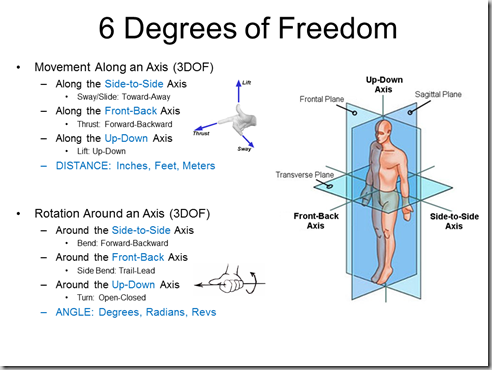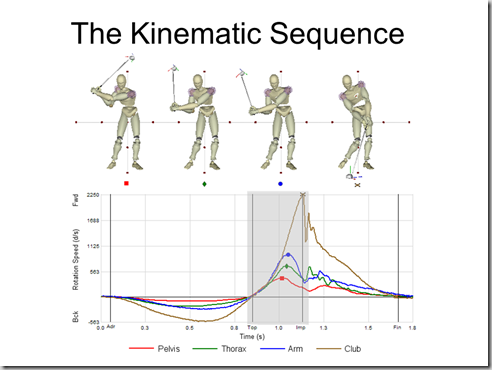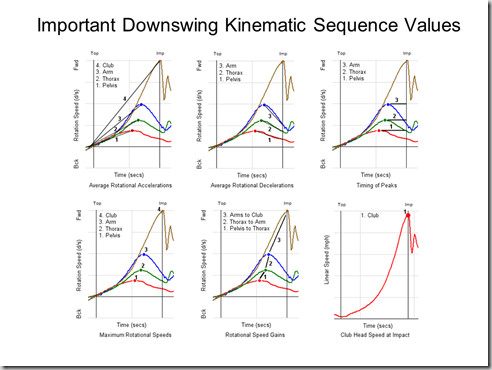Lindsey Newman
New
Ok, I guess I have to ask,
Hey mgranato! What happened 2 weeks ago?
Hey mgranato! What happened 2 weeks ago?
Last edited:
Analyzing the Golf Swing in 6 Degrees of Freedom with AMM 6DOF Systems
by PHILCHEETHAM on JUNE 6, 2012
What is 6DOF?
Six-degrees-of-freedom (6DOF) means you can move six ways; forward/backward, left/right, up/down; these movements are linear, determine your position and are measured in feet, inches, meters etc. You can also turn, plus bend forward/backward or side to side; these movements are angular, determine your orientation and are measured in degrees.
When you measure something you first need to measure it from something else; that “something else” is called the reference point or reference frame and is considered the (0, 0, 0) point. You can measure any other point from that point by going forward, sideways and up; or, of course backwards, sideways and down and in any order. As I said earlier, these movements are measured in feet, inches, meters, etc. These three-dimensions account for three of the 6DOF we are discussing.
Once you have moved to that position by moving in three-dimensions, you can change your orientation and bend forward, sideways or turn; orientation is measured in degrees. These are another three degrees of freedom. So the three position movements and the three angle movements make up the 6DOF.

How is this important to the golf swing? Every part of your body can be considered to move with 6DOF, for example, your pelvis (hips) at the address position will have a certain position and orientation and that will be a different position/orientation to the top of backswing and again different to impact and finish. So at the top of your backswing your hips will have turned, tipped sideways and tilted backwards. They may also have swayed sideways, thrust forward and lifted up compared to where you were at address. So to get all the motions we need to measure all six of these values; we need to measure in 6DOF.
By the way, your spine is not stiff during the golf swing; it is flexible and so your pelvis and thorax can move independently of each other; yes, in 6DOF. (Note; we use the term “thorax” to mean upper body or ribcage. Please see the explanation at the end of this article). You don’t only turn your spine during a swing; you bend and side-bend as well. In fact this is where you get a huge amount of your power from, but unfortunately if strength is not maintained it is also how back injuries occur. So, measuring these two prime movers (pelvis and thorax) in 6DOF during the swing is very important. Several systems out there today only measure angles (3DOF); they are missing half of the picture!

AMM 6DOF Systems
Advanced Motion Measurement, Inc., (AMM) has several systems that can measure 6DOF during the golf swing. They all include the TPI 3D biomechanics methodology. They range from the comprehensive full body AMM3D motion capture system using 12 electromagnetic sensors attached to your limbs, head and body; to the new three sensor Walkabout 6D Golf system that measures the club, pelvis and thorax.
Surprisingly with only three sensors the Walkabout system measures many important aspects of the swing in 6DOF. I’ll discuss these systems subsequently but first I want to explain the Kinematic Sequence.
The Kinematic Sequence
All of the AMM systems measure the Kinematic Sequence of the body during the swing. This gives us a measure of the dynamic efficiency of the swing. It tells us how we are generating energy and whether we are doing it in the best possible way. The Kinematic Sequence is a measure of the turning speed of the pelvis and thorax, plus the swing speed of the arms and club shaft. It is a graph of these curves, (sometimes others may be added). An example is shown below.

There is a huge amount of information in just these four curves. We can tell the sequence of motion in your takeaway. We can tell the sequence of motion in you transition from backswing to downswing. The transition sequence is very important in power generation because of the way that muscles work. If a muscle is stretched before it contracts then it can contract stronger. This is called the stretch-shorten cycle of muscle. So if we see your pelvis transition before your upper body then we know that there is an extra stretch going on in your mid-section, helping those muscles to provide more power. The same extra stretch can occur at the shoulder joints and the wrist joints, and we can measure that too.

Surprisingly to some, during the downswing your body doesn’t accelerate all the way in to impact, only the club does. Actually each part of your body first accelerates in the downswing, and then decelerates just before impact. This happens naturally and is similar to “cracking a whip”. First the handle of the whip speeds up then it sharply slows down in order to transmit the energy to the tip of the whip so that it cracks. The analogy of the golf swing to this is not perfect but it is instructive. So in the golf swing all parts of your body and the club speed up during the early part of the downswing (as indicated by the up-slope of all four curves) but after a few fractions of a second the pelvis slows down and speed is transferred and increased across the core by the mid-section muscles. This allows the upper body to be “sling-shot” faster into the downswing. This sequence then repeats, with the upper body slowing down as the arms continue to speed up; energy is created and transmitted across the shoulder joint to speed up the arms. Next the arms slow down as the club is released into the ball with maximum possible speed. The characteristics of this downswing sequence are:
first acceleration then deceleration,
each segment’s speed peaks and decelerates after the previous one in a sequential manner,
each segment’s speed peaks higher than the previous one, with speed being gained across each joint, caused by the timely action of the muscles across that joint.
In the picture below you can see all the kinematic sequence parameters that were measured and compared between novice and elite golfers in our research that was published in the World Scientific Congress of Golf proceedings (Cheetham, et. al., 2008), they include; accelerations, decelerations, timing of peak velocities, values of peak velocities, speed gain from segment to segment, and calculated club head linear speed.

Dam! if I didnt get edumicated again here!Granato this is one hell of a post!
Me personally?.....
Never witnessed one player get better solely focusing on hips and how they rotate. Not one.
Two weeks ago I would have completely agreed with this.
Ok, I guess I have to ask,
Hey mgranato! What happened 2 weeks ago?
I'd bet a dollar to a doughnut that the hip app has a lot to do with it, Mike. I've been using it on the course and it is a game-changer. By focusing on the pelvic action, there is a certain zen freedom to the rest of the swing.

Me personally?.....
Never witnessed one player get better solely focusing on hips and how they rotate. Not one.
Do "candy cane" hips play into this at all?
I'd bet a dollar to a doughnut that the hip app has a lot to do with it, Mike. I've been using it on the course and it is a game-changer. By focusing on the pelvic action, there is a certain zen freedom to the rest of the swing.
Wow! Can't disagree with you more
